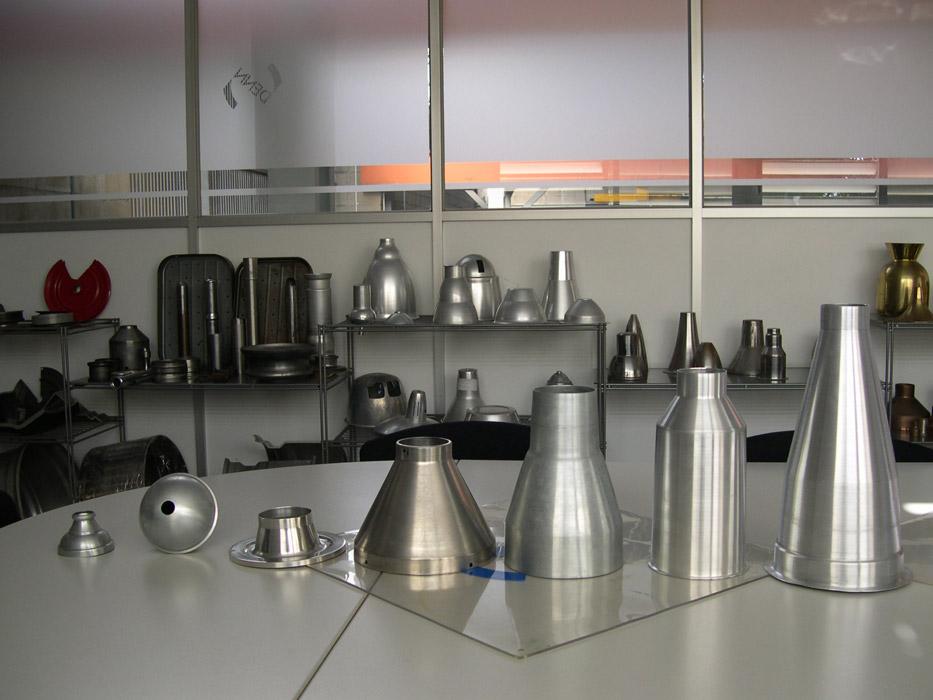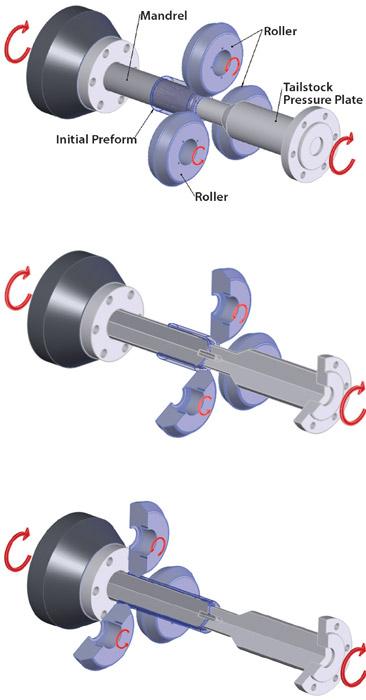President
- FMA
- The Fabricator
- FABTECH
- Canadian Metalworking
Categories
- Additive Manufacturing
- Aluminum Welding
- Arc Welding
- Assembly and Joining
- Automation and Robotics
- Bending and Forming
- Consumables
- Cutting and Weld Prep
- Electric Vehicles
- En Español
- Finishing
- Hydroforming
- Laser Cutting
- Laser Welding
- Machining
- Manufacturing Software
- Materials Handling
- Metals/Materials
- Oxyfuel Cutting
- Plasma Cutting
- Power Tools
- Punching and Other Holemaking
- Roll Forming
- Safety
- Sawing
- Shearing
- Shop Management
- Testing and Measuring
- Tube and Pipe Fabrication
- Tube and Pipe Production
- Waterjet Cutting
Industry Directory
Webcasts
Podcasts
FAB 40
Advertise
Subscribe
Account Login
Search
Metal spinning versus flow forming
Although similar, each is designed for different applications
- By Dirk Palten and Josep Mont
- October 27, 2016
- Article
- Bending and Forming

Figure 1
All of these parts were produced with metal spinning, with the workpiece being formed over a mandrel.
Metal spinning originated as a handcraft technique with origins, according to some, dating back to 10th-century China. Nowadays it is a powerful and advanced manufacturing process carried out by CNC machines.
Today the industrial spinning industry not only uses precision metal spinning, but also a closely related process called flow forming. In fact, flow forming can be considered to be a specialized kind of spinning process.
Both metal spinning and flow forming can make workpieces from just a few inches in diameter up to several feet in diameter and lengths. Flow forming today produces parts for the nuclear, oil and gas, chemical, and medical industries, among others. Metal spinning technology can be found in a broad range of fields, from decorative components and general industrial products to aerospace and defense components (see Figures 1 and 2).
What Is Metal Spinning?
Metal spinning produces axisymmetric workpieces starting from a blank. This blank is commonly a flat disk sheet and occasionally a deep-drawn or machined preform. The blank is clamped against a rotating mandrel using a tailstock system, and the mandrel is shaped with the profile of the inner final workpiece. Once the blank is clamped and rotated, forming slides drive a rotating tool called a roller against the blank. With consecutive movements called strokes or passes, the roller pushes the blank against the mandrel (see Figure 3).
After several backward and forward forming passes, starting next to the mandrel surface to the edge of the disk blank, the material progressively forms closer to the mandrel until the final shape is obtained. A final pass leaves a good finish quality and forms the material tightly to the mandrel to satisfy dimensional and tolerance requirements.
Metal spinning has several iterations that suit different applications. Among them, multipass spinning is the most common; as described earlier, a roller makes forming passes across the spinning disk multiple times, shaping the metal against the mandrel.
Another common iteration, shear forming, finishes a part in just one pass, with the roller pressing against the metal in a unique fashion. In multipass spinning, the unformed flange section of the disk bends forward and backward during the process, depending on the type and direction of the spinning passes. In shear forming, the roller keeps that spinning flange perfectly vertical during the process.
Besides multipass spinning and shear forming is another, less common metal spinning iteration called necking-in or reducing—sometimes referred to as “spinning on air.” As the name implies, it usually requires no mandrel for internal support. It is commonly used for shapes such as gas bottles, which are necked-in out of a tube.
What Is Flow Forming?
Flow forming produces axisymmetric cylindrical workpieces starting from hollowed tubes, premachined blanks, or forged or deep-drawn parts. The initial part is clamped against the rotating mandrel with a tailstock system. Three forming rollers are distributed equally in a circle, each 120 degrees apart, and can move axially and longitudinally. Once the system rotates, the rollers push against the material in the axial direction all along the length of the preform. Consequently, the material is stretched in this movement direction, thinning the preform wall to keep the initial material volume (see Figure 4).
Flow forming typically requires one to three axial strokes, or passes, each one stretching and reducing the wall thickness. The number of strokes depends on different factors, such as the preform initial thickness and final part thickness relationship, material formability, and machine forces. After the flow forming operation is finished, the machine’s extractor system ejects the workpiece.

Figure 2
These tubular parts were flow-formed to precise ID and OD dimensions. Material thickness is extremely consistent and uniform throughout.
Although three-roller flow forming machines are still most common, machinery with more than three rollers is also being employed to achieve greater forming forces and production speeds.
Metal spinning excels when the final workpiece geometry has multiple diameters and material thickness reduction is not a major concern. The products manufactured with flow forming are more restricted—mainly to pipes and tubes with highly precise geometries, including their inside diameters and thicknesses.
Flow forming also strengthens the material, which presents some economic advantages. The process starts with thick, short preforms to obtain long, thinner-walled and precise final parts.
Blanks and Preforms
Metal spinning and flow forming have noteworthy differences in the initial blank or preform used, mainly because the final workpiece produced by each process has different requirements. About 90 percent of spun parts can be formed by starting with a blank disk trimmed from standard commercial sheet metal. When starting with a disk blank is not a viable option, normally because the final workpiece has complex shapes or thickness variation, metal spinning can use premachined, forged, or deep-drawn preforms.
Flow forming usually starts with preforms that have been deep-drawn or machined. Just a few flow forming applications can start with commercially available raw material preforms.
Differences in Execution
Metal spinning uses a consecutive number of passes to form the blank. Only in the final stage of those strokes is the material pressed against the mandrel, with the material thickness being controlled. For this reason, it is somewhat difficult for metal spinning to produce a workpiece of uniform thickness throughout the process. Metal spinning uses only one, sometimes two, rollers, and only the roller tips control the workpiece shape and thickness.
In flow forming, three or more rollers apply constant pressure against the material and mandrel throughout each stroke. Using parameters from the CNC, the machine controls the pressure and the workpiece thickness at the forming rollers’ point of contact, all along the stroke. The result: Flow forming can produce a part with a highly accurate, uniform material thickness.
Materials
Some materials in certain conditions can be formed only in warm or hot conditions, with torches, induction heating systems, or ovens heating the material. But for the most part, both metal spinning and flow forming are considered cold forming processes.
Cold working positively affects the workpiece’s mechanical properties, producing improved grain structures and increased tensile strength. How much cold working takes place in the workpiece depends on the wall thickness reduction.
These improved mechanical properties usually are more important in flow forming than in metal spinning, because the amount of wall reduction applied to flow formed parts is much greater. Regardless, the maximum thickness reduction depends on the material and its initial metallurgical conditions; it is not related to the forming process.

Figure 3
In most metal spinning processes, the shape of the mandrel determines the final shape of the workpiece.
Metal spinning and flow forming can be used to form a variety of materials, and some materials are easier to form than others, both from a dimensional and process control perspective. For instance, metal spinning aluminum can be quite easy to control, while flow forming aluminum can be much more complex (see Figure 5).
Equipment
Metal spinning lathes (also called spin forming machines) and flow forming lathes have common basic components such as headstocks, tailstocks, and working unit slides.
Flow forming machines are designed and built to be robust enough to handle the high forming forces of the process, including the high forming forces needed when starting with thick blanks (see Figure 6). Spinning machines are faster because the parts can be produced with high RPMs and feed rates.
Tooling
The complexity and cost of the tooling depend on the workpiece’s dimensional requirements and material hardness. Flow forming is ideal for manufacturing parts out of high-strength materials; the process’s high forming forces can produce these parts within tight dimensional and thickness tolerances. This requires the design and manufacture of hardened mandrels within tight tolerances, robust enough to produce parts in the thousands.
The materials and final-dimension accuracy produced with metal spinning are generally not as demanding. The mandrels and forming rollers usually can be designed and manufactured economically.
Complementary Processes
Sometimes using both techniques can solve a manufacturing puzzle. For example, some operations use metal spinning to start from a blank disk and manufacture a spun part that, in turn, can be used as a preform for flow forming, which forms the part to its final dimensions.
The exact process depends on the material. Some workpiece materials can go right from metal spinning to flow forming, while other material types require annealing after spinning to make the material formable again for the flow forming process.
Conclusion
Though both processes are very similar, each has important differences regarding the final workpieces they can achieve. Flow forming is the best process when part shapes are cylindrical, have a high length-to-diameter ratio, and dimensional accuracy (inside diameter, outside diameter, and thickness) is important. Metal spinning is a more common and versatile process when high dimensional accuracy is not necessary, especially for highly formable metals.
Which process suits best? That depends, as it always does, on the application requirements.
About the Authors
Dirk Palten
719-282-9061
Related Companies
subscribe now

The Fabricator is North America's leading magazine for the metal forming and fabricating industry. The magazine delivers the news, technical articles, and case histories that enable fabricators to do their jobs more efficiently. The Fabricator has served the industry since 1970.
start your free subscription- Stay connected from anywhere

Easily access valuable industry resources now with full access to the digital edition of The Fabricator.

Easily access valuable industry resources now with full access to the digital edition of The Welder.

Easily access valuable industry resources now with full access to the digital edition of The Tube and Pipe Journal.
- Podcasting
- Podcast:
- The Fabricator Podcast
- Published:
- 04/16/2024
- Running Time:
- 63:29
In this episode of The Fabricator Podcast, Caleb Chamberlain, co-founder and CEO of OSH Cut, discusses his company’s...
- Trending Articles
How to set a press brake backgauge manually

Capturing, recording equipment inspection data for FMEA

Tips for creating sheet metal tubes with perforations

Are two heads better than one in fiber laser cutting?

Hypertherm Associates implements Rapyuta Robotics AMRs in warehouse

- Industry Events
16th Annual Safety Conference
- April 30 - May 1, 2024
- Elgin,
Pipe and Tube Conference
- May 21 - 22, 2024
- Omaha, NE
World-Class Roll Forming Workshop
- June 5 - 6, 2024
- Louisville, KY
Advanced Laser Application Workshop
- June 25 - 27, 2024
- Novi, MI



























